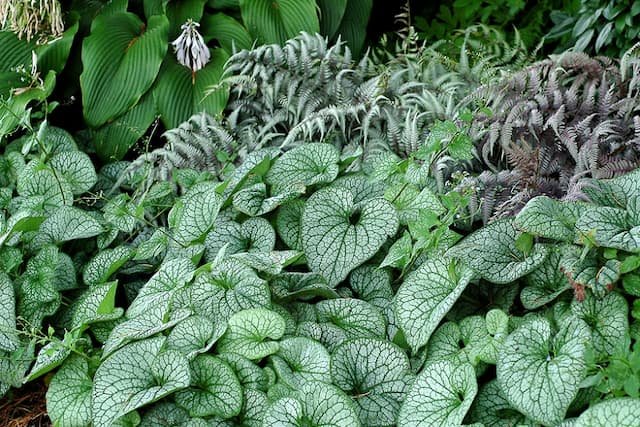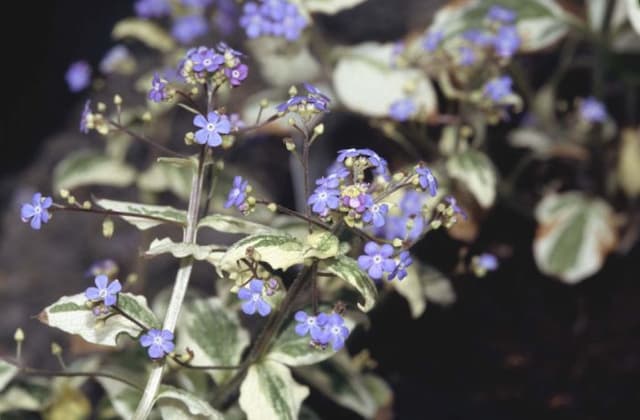Chatham Island forget-me-not Myosotidium hortensia

ABOUT
The plant commonly known as the Chatham Islands forget-me-not is a visually striking species. It boasts broad, glossy, deep green leaves that have a somewhat fleshy and succulent texture. The foliage can appear almost heart-shaped, providing a lush and exotic background for the flowers. The blooms of this plant are truly captivating, typically forming in clusters. These floral clusters are composed of many small, star-shaped flowers that may range in color, with shades such as stunning blues or purples being quite common. Each individual flower features a prominent center that contrasts the petal color, often appearing in a lighter tone. The overall effect of the plant's foliage coupled with its impressive blossoms gives it a robust and vibrant appearance, making it a beloved ornamental choice for garden enthusiasts.
About this plant
 Names
NamesFamily
Boraginaceae.
Synonyms
Chatham Islands Forget-me-not, Broadleaf Forget-me-not.
Common names
Myosotidium hortensia
 Toxicity
ToxicityTo humans
The Chatham Island forget-me-not is not commonly known to be toxic to humans. There is limited information on the toxicity of this plant, and it is generally not considered a hazard if accidentally ingested in small quantities. However, as with many plants, it is advisable to exercise caution and avoid ingestion since individual sensitivity can vary, and there may be unknown compounds that could cause adverse effects in some people.
To pets
The Chatham Island forget-me-not is not widely recognized as toxic to pets. There is no well-documented evidence of toxicity in domestic animals such as cats and dogs. Nevertheless, it is always prudent to prevent pets from ingesting plants since individual animals can exhibit sensitivity, and non-toxic plants can sometimes cause mild gastrointestinal upset if eaten in large amounts. If you suspect your pet has ingested a substantial quantity of this plant and is showing signs of illness, it is best to consult with a veterinarian.
 Characteristics
CharacteristicsLife cycle
Perennials
Foliage type
Evergreen
Color of leaves
Green
Flower color
Blue
Height
2 feet [60 cm]
Spread
2 feet [60 cm]
Plant type
Herb
Hardiness zones
7
Native area
Chatham Islands
Benefits
 General Benefits
General Benefits- Aesthetic Appeal: Myosotidium hortensia, commonly known as the Chatham Islands forget-me-not, boasts large, glossy leaves and striking blue flowers, adding visual interest to gardens and landscapes.
- Pollinator Attraction: The flowers of the Chatham Islands forget-me-not attract various pollinators, including bees and butterflies, promoting biodiversity.
- Coastal Adaptation: This plant is naturally adapted to coastal environments, tolerating salt spray and windy conditions, making it suitable for seaside gardens.
- Low Maintenance: Once established, Myosotidium hortensia requires minimal care, making it a low-maintenance option for gardeners.
- Erosion Control: Its robust root system can help stabilize soil, reducing erosion on banks and slopes.
- Seasonal Interest: The Chatham Islands forget-me-not provides seasonal interest with its vibrant bloom in spring and early summer.
 Medical Properties
Medical PropertiesThis plant is not used for medical purposes.
 Air-purifying Qualities
Air-purifying QualitiesThis plant is not specifically known for air purifying qualities.
 Other Uses
Other Uses- Chatham Island Forget-me-not (Myosotidium hortensia) can be used as a coastal windbreak in landscaping due to its tolerance to sea breezes.
- The plant's large attractive leaves can be used in floral arrangements to create a lush, tropical aesthetic.
- Chatham Island Forget-me-not's striking blue flowers can be used as natural dye for fabrics, although this is not a common practice.
- In garden design, the plant is useful for creating focal points due to its bold foliage and vibrant blooms.
- The thick leaves of the Chatham Island Forget-me-not can be used as a natural mulch to help retain soil moisture.
- Gardeners might plant Chatham Island Forget-me-nots to attract pollinators like bees and butterflies to their gardens.
- It can be used in educational settings, such as botanical gardens, to demonstrate plant adaptation and evolution on isolated islands.
- Suitable for container gardening, Myosotidium hortensia can be grown indoors which allows those in colder climates to enjoy its beauty.
- As groundcover, this plant can help prevent soil erosion in sloped areas of a garden with its root system.
- Chatham Island Forget-me-not can be used in sensory gardens, where its distinctive texture and colorful bloom can be enjoyed by those with vision impairments.
Interesting Facts
 Feng Shui
Feng ShuiThe Chatham Islands forget-me-not is not used in Feng Shui practice.
 Zodiac Sign Compitability
Zodiac Sign CompitabilityThe Chatham Islands forget-me-not is not used in astrology practice.
 Plant Symbolism
Plant Symbolism- Remembrance: Myosotidium hortensia, commonly known as Chatham Island forget-me-not, often symbolizes memory and remembrance, reflecting its place within the Myosotis genus where true forget-me-nots belong, carrying forward the same symbolic meaning of not being forgotten.
- Love and Respect: Chatham Island forget-me-nots can represent deep love and respect, as the name itself beckons the bearer to hold someone dear in their thoughts perpetually.
- Strength and Resilience: Native to the rugged Chatham Islands, these plants embody strength and resilience, as they thrive in a harsh climate, making them a symbol of enduring adverse conditions.
- Rare Beauty: As a plant with large, attractive blue flowers, Chatham Island forget-me-not symbolizes a rare and unique beauty, often found in isolated or remote locations, just as the plant is a standout specimen in its native habitat.
 Water
WaterThe Chatham Islands forget-me-not requires consistent moisture and should be watered thoroughly, allowing the top inch of soil to dry out slightly between waterings. Typically, this equates to watering once every week, but this can fluctuate based on environmental conditions like heat and humidity. It’s crucial to avoid waterlogging, so providing approximately 1 gallon per watering session for a medium-sized plant should suffice. Decrease the amount of water during the winter months when the plant is not actively growing.
 Light
LightThe Chatham Islands forget-me-not thrives in bright, indirect light and should be positioned in a spot where it can receive such conditions away from direct sunlight that can burn its leaves. An ideal placement would be in an east or west-facing room where it gets gentle morning or late afternoon sun.
 Temperature
TemperatureThe Chatham Islands forget-me-not prefers cooler temperature conditions, thriving best between 50 to 60 degrees Fahrenheit. It can withstand minimum temperatures down to about 30 degrees Fahrenheit but should be protected from frost. The ideal temperature range maintains a cool environment without getting too cold, thereby ensuring healthy growth.
 Pruning
PruningPrune the Chatham Islands forget-me-not to maintain shape and encourage fuller growth, typically by snipping off the tips of the plants. Pruning is best done in early spring or after the plant has finished flowering. This plant doesn't require frequent pruning; doing so once a year is sufficient.
 Cleaning
CleaningAs needed
 Soil
SoilFor the Chatham Islands forget-me-not, a rich, well-draining soil mix with a pH of 6.5-7.5 is ideal. Incorporate peat moss, compost, and a small amount of sand to improve aeration and moisture retention.
 Repotting
RepottingChatham Islands forget-me-nots should be repotted every 2-3 years, or when the plant has outgrown its current container, to ensure continued health and growth.
 Humidity & Misting
Humidity & MistingChatham Islands forget-me-not thrives at high humidity levels, ideally around 70%, mimicking its native habitat's coastal conditions.
 Suitable locations
Suitable locationsIndoor
Bright indirect light, well-draining soil, moderate watering.
Outdoor
Partial shade, shelter from wind, moist, fertile soil.
Hardiness zone
7-10 USDA
 Life cycle
Life cycleMyosotidium hortensia, commonly known as Chatham Island forget-me-not, begins its life cycle with seed germination, where it requires moist, well-drained soil and a cool environment to sprout. It then enters a vegetative growth stage, characterized by the development of large, glossy, green leaves which form a basal rosette. As it matures, the plant produces striking blue or white flower clusters on sturdy stalks in spring and early summer, which attract pollinators for sexual reproduction. After pollination, the flowers develop into fruits containing seeds, completing the reproductive phase. The plant may enter a state of dormancy during unfavorable seasonal conditions, especially in colder climates, to conserve energy. Myosotidium hortensia can live for several years, with proper care and protection from harsh winter frosts, continuing its life cycle through reseeding or occasionally by division.
 Propogation
PropogationPropogation time
Spring-early summer
Propogation: Chatham Island forget-me-not, or Myosotidium hortensia, is best propagated in the spring when the temperatures are mild and conducive to plant growth. The most popular method of propagation for this plant is by seed. Collect seeds when the seed heads dry on the plant, then sow them in a well-draining seed starting mix, lightly covering them with soil. Maintain a constant moisture level but avoid waterlogging, and place them in a warm spot with bright, indirect light. Germination can be slow and may take several weeks, so patience is essential. Once seedlings have developed a few sets of true leaves and are large enough to handle, they can be carefully transplanted into individual pots to grow on before being moved to their final position.









